PORSCHE CAYNNE 2004 1.G Owners Manual
Manufacturer: PORSCHE, Model Year: 2004, Model line: CAYENNE, Model: PORSCHE CAYENNE 2004 1.GPages: 379, PDF Size: 13.91 MB
Page 301 of 379
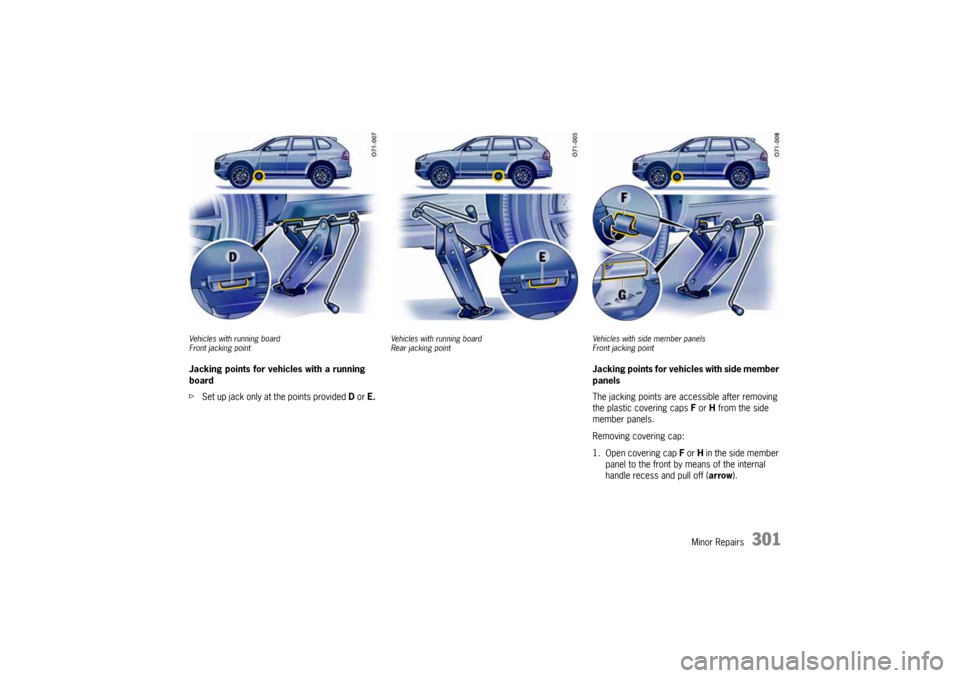
Minor Repairs
301
Vehicles with running board
Front jacking pointJacking points for vehicles with a running
board
fSet up jack only at the points provided D or E.
Vehicles with running board
Rear jacking pointVehicles with side member panels
Front jacking point
Jacking points for vehicles with side member
panels
The jacking points are accessible after removing
the plastic covering caps F or H from the side
member panels.
Removing covering cap:
1. Open covering cap F or H in the side member
panel to the front by means of the internal
handle recess and pull off (arrow).
10_Cayenne_21_KW17.book Seite 301 Donnerstag, 9. April 2009 3:33 15
Page 302 of 379
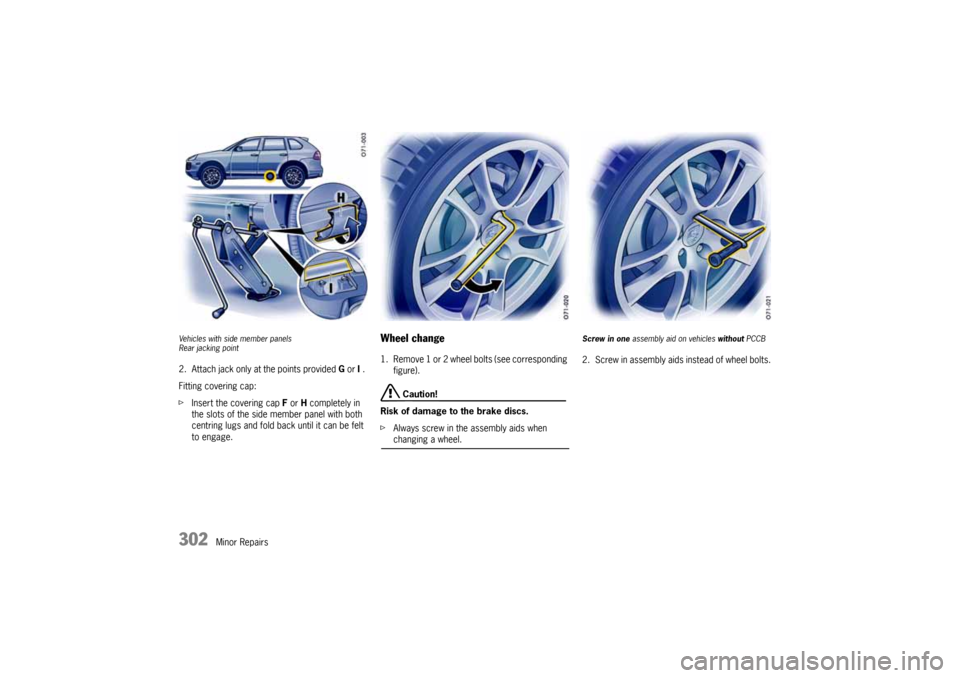
302
Minor Repairs
Vehicles with side member panels
Rear jacking point2. Attach jack only at the points provided G or I .
Fitting covering cap:
fInsert the covering cap F or H completely in
the slots of the side member panel with both
centring lugs and fold back until it can be felt
to engage.
Wheel change1. Remove 1 or 2 wheel bolts (see corresponding
figure).
Caution!
Risk of damage to the brake discs.
fAlways screw in the assembly aids when changing a wheel.
Screw in one assembly aid on vehicles without PCCB2. Screw in assembly aids instead of wheel bolts.
10_Cayenne_21_KW17.book Seite 302 Donnerstag, 9. April 2009 3:33 15
Page 303 of 379
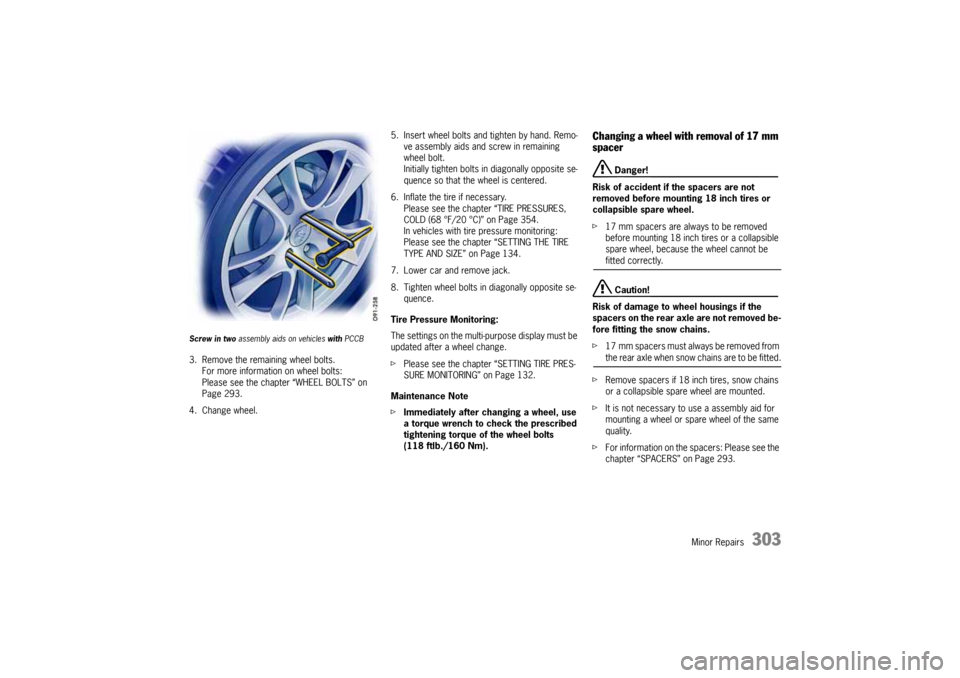
Minor Repairs
303
Screw in two assembly aids on vehicles with PCCB3. Remove the remaining wheel bolts.
For more information on wheel bolts:
Please see the chapter “WHEEL BOLTS” on
Page 293.
4. Change wheel.5. Insert wheel bolts and tighten by hand. Remo-
ve assembly aids and screw in remaining
wheel bolt.
Initially tighten bolts in diagonally opposite se-
quence so that the wheel is centered.
6. Inflate the tire if necessary.
Please see the chapter “TIRE PRESSURES,
COLD (68 °F/20 °C)” on Page 354.
In vehicles with tire pressure monitoring:
Please see the chapter “SETTING THE TIRE
TYPE AND SIZE” on Page 134.
7. Lower car and remove jack.
8. Tighten wheel bolts in diagonally opposite se-
quence.
Tire Pressure Monitoring:
The settings on the multi-purpose display must be
updated after a wheel change.
fPlease see the chapter “SETTING TIRE PRES-
SURE MONITORING” on Page 132.
Maintenance Note
fImmediately after changing a wheel, use
a torque wrench to check the prescribed
tightening torque of the wheel bolts
(118 ftlb./160 Nm).
Changing a wheel with removal of 17 mm
spacer
Danger!
Risk of accident if the spacers are not
removed before mounting 18 inch tires or
collapsible spare wheel.
f17 mm spacers are always to be removed
before mounting 18 inch tires or a collapsible
spare wheel, because the wheel cannot be fitted correctly. Caution!
Risk of damage to wheel housings if the
spacers on the rear axle are not removed be-
fore fitting the snow chains.
f17 mm spacers must always be removed from the rear axle when snow chains are to be fitted.
fRemove spacers if 18 inch tires, snow chains
or a collapsible spare wheel are mounted.
fIt is not necessary to use a assembly aid for
mounting a wheel or spare wheel of the same
quality.
fFor information on the spacers: Please see the
chapter “SPACERS” on Page 293.
10_Cayenne_21_KW17.book Seite 303 Donnerstag, 9. April 2009 3:33 15
Page 304 of 379
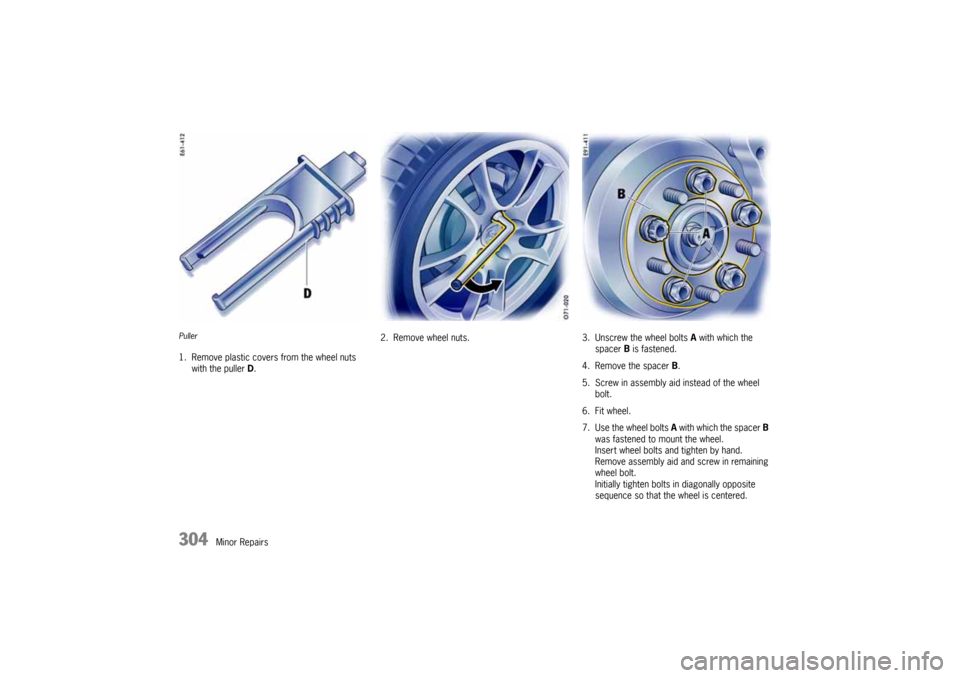
304
Minor Repairs
Puller1. Remove plastic covers from the wheel nuts
with the puller D.2. Remove wheel nuts. 3. Unscrew the wheel bolts A with which the
spacer B is fastened.
4. Remove the spacer B.
5. Screw in assembly aid instead of the wheel
bolt.
6. Fit wheel.
7. Use the wheel bolts A with which the spacer B
was fastened to mount the wheel.
Insert wheel bolts and tighten by hand.
Remove assembly aid and screw in remaining
wheel bolt.
Initially tighten bolts in diagonally opposite
sequence so that the wheel is centered.10_Cayenne_21_KW17.book Seite 304 Donnerstag, 9. April 2009 3:33 15
Page 305 of 379
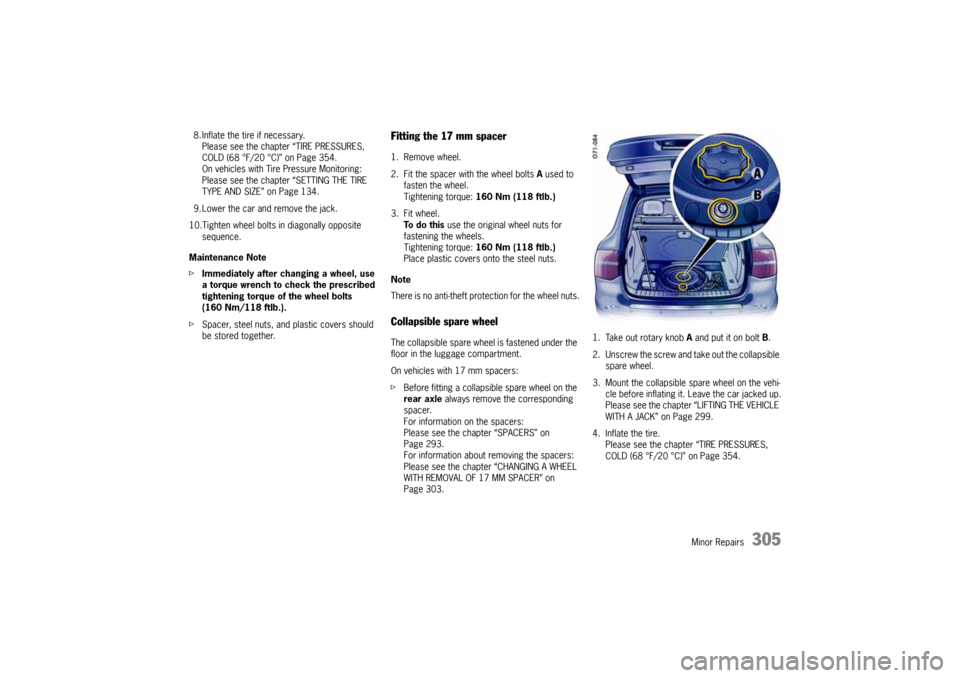
Minor Repairs
305
8. Inflate the tire if necessary.
Please see the chapter “TIRE PRESSURES,
COLD (68 °F/20 °C)” on Page 354.
On vehicles with Tire Pressure Monitoring:
Please see the chapter “SETTING THE TIRE
TYPE AND SIZE” on Page 134.
9. Lower the car and remove the jack.
10.Tighten wheel bolts in diagonally opposite
sequence.
Maintenance Note
fImmediately after changing a wheel, use
a torque wrench to check the prescribed
tightening torque of the wheel bolts
(160 Nm/118 ftlb.).
fSpacer, steel nuts, and plastic covers should
be stored together.
Fitting the 17 mm spacer1. Remove wheel.
2. Fit the spacer with the wheel bolts A used to
fasten the wheel.
Tightening torque: 160 Nm (118 ftlb.)
3. Fit wheel.
To d o t h i s use the original wheel nuts for
fastening the wheels.
Tightening torque: 160 Nm (118 ftlb.)
Place plastic covers onto the steel nuts.
Note
There is no anti-theft protection for the wheel nuts.Collapsible spare wheelThe collapsible spare wheel is fastened under the
floor in the luggage compartment.
On vehicles with 17 mm spacers:
fBefore fitting a collapsible spare wheel on the
rear axle always remove the corresponding
spacer.
For information on the spacers:
Please see the chapter “SPACERS” on
Page 293.
For information about removing the spacers:
Please see the chapter “CHANGING A WHEEL
WITH REMOVAL OF 17 MM SPACER” on
Page 303.1. Take out rotary knob A and put it on bolt B.
2. Unscrew the screw and take out the collapsible
spare wheel.
3. Mount the collapsible spare wheel on the vehi-
cle before inflating it. Leave the car jacked up.
Please see the chapter “LIFTING THE VEHICLE
WITH A JACK” on Page 299.
4. Inflate the tire.
Please see the chapter “TIRE PRESSURES,
COLD (68 °F/20 °C)” on Page 354.
10_Cayenne_21_KW17.book Seite 305 Donnerstag, 9. April 2009 3:33 15
Page 306 of 379

306
Minor Repairs
Warning!
Risk of accident.
fThe collapsible spare wheel must be used only
over short distances in cases of emergency.
For safety reasons, replace the tires before
the wear indicators appear (webs in the tire
grooves, 1/16 in. (1.6 mm) high).
fNever deactivate the Porsche Stability
Management (PSM) system.
fAvoid hard acceleration and high cornering
speeds.
The maximum permitted speed is 50 mph
(80 km/h) and must not be exceeded
because of altered driving characteristics and
for reasons of wear.
The tread depth of the spare wheel is subject
to the same laws as the original tires.
fDo not use a collapsible spare wheel from a
different vehicle type.
fDo not mount the collapsible spare wheel from
your car on a different vehicle.
fOnly fit one collapsible spare wheel on the
vehicle at a time.
fOn vehicles with air suspension, use the tire fil-
ling connection A only to inflate the collapsible
spare wheel.
fTo avoid damage, do not use automatic car washes when the spare wheel is installed.After using the collapsible spare wheel
fRelease air by unscrewing the valve insert.
Notes on operation
The tire will revert to its original shape only after
several hours. Only then can it be stowed in the
spare wheel recess in the luggage compartment.
There is a plastic sheet in the tool box to store the
damaged wheel.
Maintenance Note
The collapsible spare wheel must be repaired only
by the manufacturer.
fPlease consult your authorized Porsche dealer
if the collapsible spare wheel is defective.
Checking tire pressure with a pressure
gage1. Remove the valve stem cap from the tire.
2. Press the pressure gage onto the valve stem.
Note on operation
fDo not press too hard or force the valve stem
sideways, or air will escape.
If the sound of air escaping from the tire is
heard, reposition the pressure gage.
3. Read the tire pressure on the gage stem and
compare it to the permissible tire pressure.
This information can be found on the tire pres-
sure plate in the left door aperture.
Please see the chapter “TIRE PRESSURES,
COLD (68 °F/20 °C)” on Page 354.
4. Remove the pressure gage.
10_Cayenne_21_KW17.book Seite 306 Donnerstag, 9. April 2009 3:33 15
Page 307 of 379
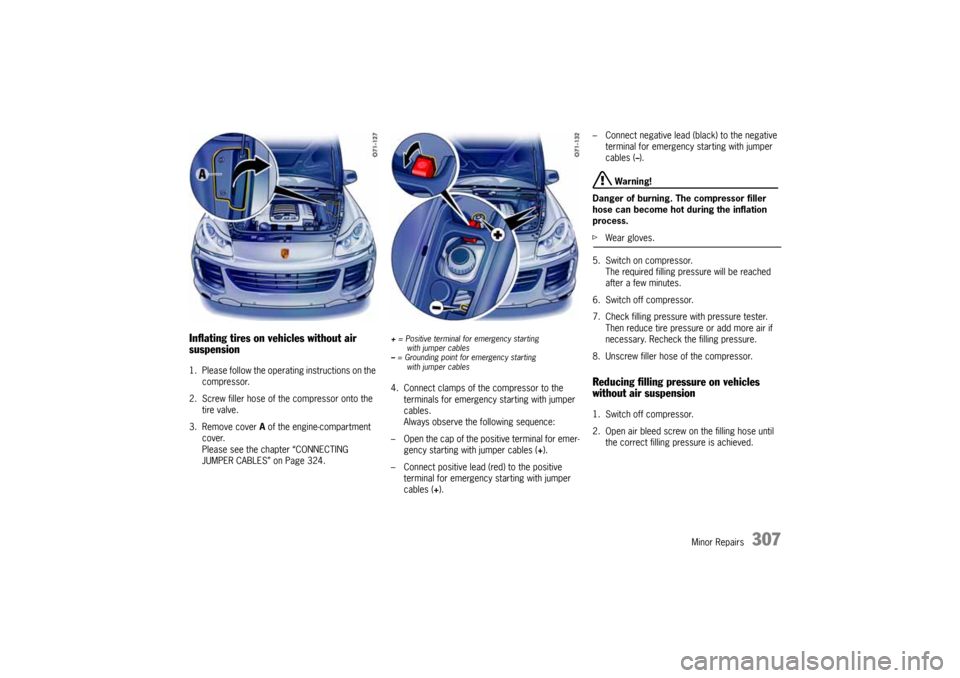
Minor Repairs
307
Inflating tires on vehicles without air
suspension1. Please follow the operating instructions on the
compressor.
2. Screw filler hose of the compressor onto the
tire valve.
3. Remove cover A of the engine-compartment
cover.
Please see the chapter “CONNECTING
JUMPER CABLES” on Page 324.
+ = Positive terminal for emergency starting
with jumper cables
– = Grounding point for emergency starting
with jumper cables4. Connect clamps of the compressor to the
terminals for emergency starting with jumper
cables.
Always observe the following sequence:
– Open the cap of the positive terminal for emer-
gency starting with jumper cables (+).
– Connect positive lead (red) to the positive
terminal for emergency starting with jumper
cables (+).– Connect negative lead (black) to the negative
terminal for emergency starting with jumper
cables (
–).
Warning!
Danger of burning. The compressor filler
hose can become hot during the inflation
process.
fWear gloves.
5. Switch on compressor.
The required filling pressure will be reached
after a few minutes.
6. Switch off compressor.
7. Check filling pressure with pressure tester.
Then reduce tire pressure or add more air if
necessary. Recheck the filling pressure.
8. Unscrew filler hose of the compressor.Reducing filling pressure on vehicles
without air suspension1. Switch off compressor.
2. Open air bleed screw on the filling hose until
the correct filling pressure is achieved.
10_Cayenne_21_KW17.book Seite 307 Donnerstag, 9. April 2009 3:33 15
Page 308 of 379
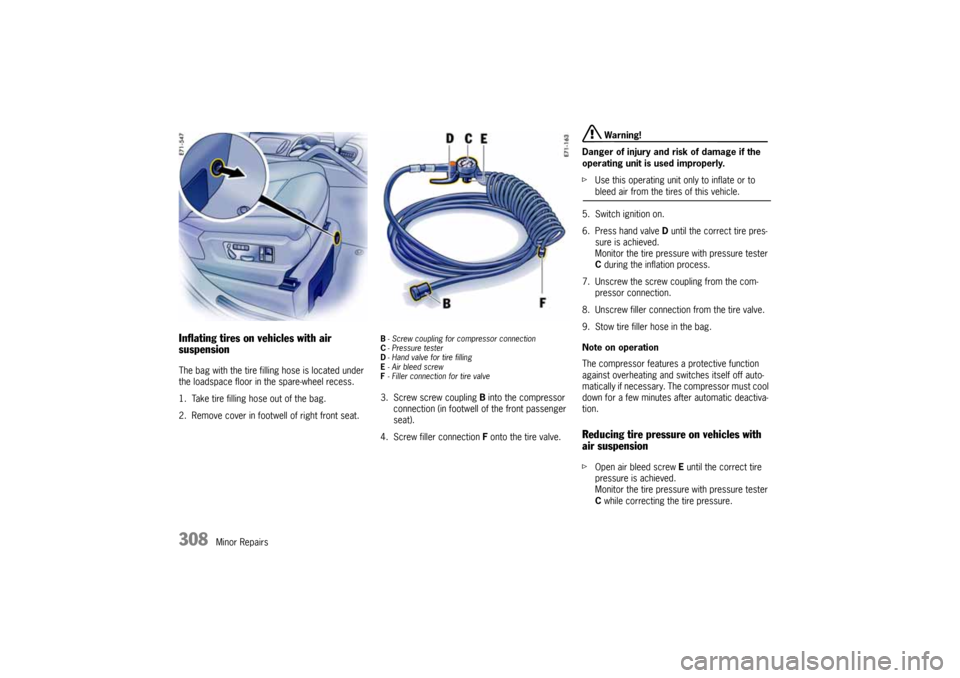
308
Minor Repairs
Inflating tires on vehicles with air
suspensionThe bag with the tire filling hose is located under
the loadspace floor in the spare-wheel recess.
1. Take tire filling hose out of the bag.
2. Remove cover in footwell of right front seat.
B- Screw coupling for compressor connection
C-Pressure tester
D- Hand valve for tire filling
E-Air bleed screw
F- Filler connection for tire valve3. Screw screw coupling B into the compressor
connection (in footwell of the front passenger
seat).
4. Screw filler connection F onto the tire valve.
Warning!
Danger of injury and risk of damage if the
operating unit is used improperly.
fUse this operating unit only to inflate or to bleed air from the tires of this vehicle.
5. Switch ignition on.
6. Press hand valve D until the correct tire pres-
sure is achieved.
Monitor the tire pressure with pressure tester
C during the inflation process.
7. Unscrew the screw coupling from the com-
pressor connection.
8. Unscrew filler connection from the tire valve.
9. Stow tire filler hose in the bag.
Note on operation
The compressor features a protective function
against overheating and switches itself off auto-
matically if necessary. The compressor must cool
down for a few minutes after automatic deactiva-
tion.
Reducing tire pressure on vehicles with
air suspensionfOpen air bleed screw E until the correct tire
pressure is achieved.
Monitor the tire pressure with pressure tester
C while correcting the tire pressure.
10_Cayenne_21_KW17.book Seite 308 Donnerstag, 9. April 2009 3:33 15
Page 309 of 379
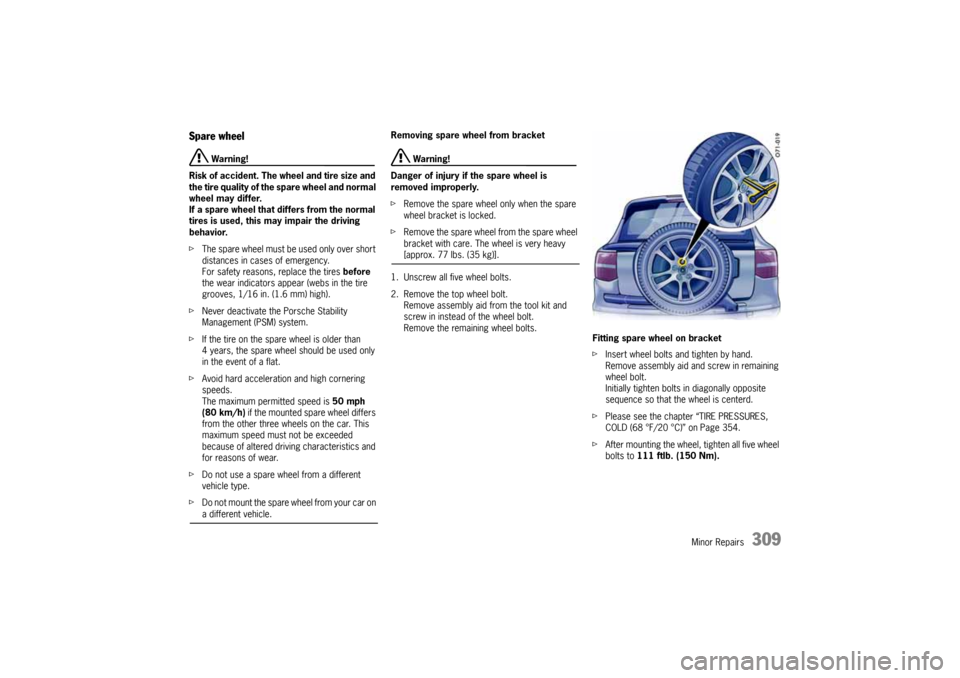
Minor Repairs
309
Spare wheel
Warning!
Risk of accident. The wheel and tire size and
the tire quality of the spare wheel and normal
wheel may differ.
If a spare wheel that differs from the normal
tires is used, this may impair the driving
behavior.
fThe spare wheel must be used only over short
distances in cases of emergency.
For safety reasons, replace the tires before
the wear indicators appear (webs in the tire
grooves, 1/16 in. (1.6 mm) high).
fNever deactivate the Porsche Stability
Management (PSM) system.
fIf the tire on the spare wheel is older than
4 years, the spare wheel should be used only
in the event of a flat.
fAvoid hard acceleration and high cornering
speeds.
The maximum permitted speed is 50 mph
(80 km/h) if the mounted spare wheel differs
from the other three wheels on the car. This
maximum speed must not be exceeded
because of altered driving characteristics and
for reasons of wear.
fDo not use a spare wheel from a different
vehicle type.
fDo not mount the spare wheel from your car on a different vehicle.Removing spare wheel from bracket
Warning!
Danger of injury if the spare wheel is
removed improperly.
fRemove the spare wheel only when the spare
wheel bracket is locked.
fRemove the spare wheel from the spare wheel
bracket with care. The wheel is very heavy [approx. 77 lbs. (35 kg)].
1. Unscrew all five wheel bolts.
2. Remove the top wheel bolt.
Remove assembly aid from the tool kit and
screw in instead of the wheel bolt.
Remove the remaining wheel bolts.
Fitting spare wheel on bracket
fInsert wheel bolts and tighten by hand.
Remove assembly aid and screw in remaining
wheel bolt.
Initially tighten bolts in diagonally opposite
sequence so that the wheel is centerd.
fPlease see the chapter “TIRE PRESSURES,
COLD (68 °F/20 °C)” on Page 354.
fAfter mounting the wheel, tighten all five wheel
bolts to 111 ftlb. (150 Nm).
10_Cayenne_21_KW17.book Seite 309 Donnerstag, 9. April 2009 3:33 15
Page 310 of 379
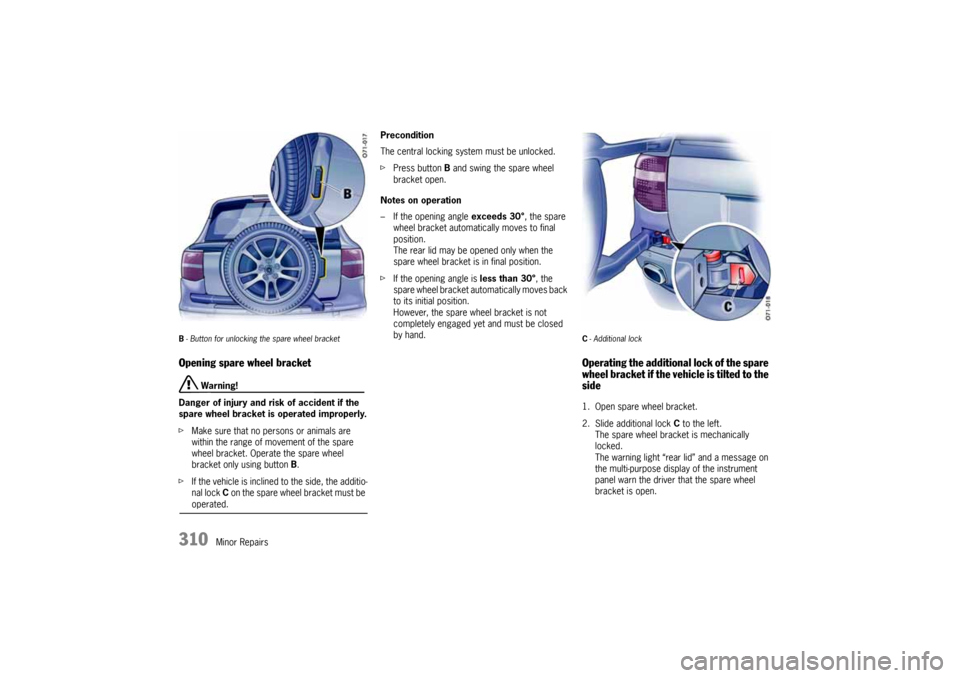
310
Minor Repairs
B- Button for unlocking the spare wheel bracketOpening spare wheel bracket
Warning!
Danger of injury and risk of accident if the
spare wheel bracket is operated improperly.
fMake sure that no persons or animals are
within the range of movement of the spare
wheel bracket. Operate the spare wheel
bracket only using button B.
fIf the vehicle is inclined to the side, the additio-
nal lock C on the spare wheel bracket must be operated.Precondition
The central locking system must be unlocked.
fPress button B and swing the spare wheel
bracket open.
Notes on operation
– If the opening angle exceeds 30°, the spare
wheel bracket automatically moves to final
position.
The rear lid may be opened only when the
spare wheel bracket is in final position.
fIf the opening angle is less than 30°, the
spare wheel bracket automatically moves back
to its initial position.
However, the spare wheel bracket is not
completely engaged yet and must be closed
by hand.
C- Additional lock Operating the additional lock of the spare
wheel bracket if the vehicle is tilted to the
side1. Open spare wheel bracket.
2. Slide additional lock C to the left.
The spare wheel bracket is mechanically
locked.
The warning light “rear lid” and a message on
the multi-purpose display of the instrument
panel warn the driver that the spare wheel
bracket is open.
10_Cayenne_21_KW17.book Seite 310 Donnerstag, 9. April 2009 3:33 15